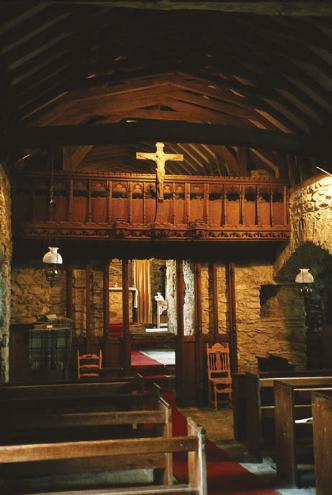

BCD Special Report on
Historic Churches
17th annual edition
37
St Eloi, Llandeloy (1924–26) from the south-east and (below the interior looking east, showing the rood loft and screen
Tis duality of ideas is something Coates
Carter shares with many architects in the
resurgent nations of central Europe, and is
characteristic of the moment: nationalist
and progressive ideas interacting.
St Eloi, Llandeloy (1925–1926), for which
Coates Carter refused to take a fee, is his swan-
song. It is his humble and loving evocation of
a small medieval Welsh church, re-invented
from a few long-abandoned medieval ruins on
an ancient site. From the outside it crouches
low against wind and weather, with walls of
roughly pointed local rubble under a long slate
roof, and a handful of small windows. Entering
by the only door, one is suddenly remote and
withdrawn from the world, and the interior has
something of the intense, sheltering stillness
and mystery of a cave or rock-cut shrine. It
is Coates Carter’s most complete surviving
interior, and is a beautiful performance.
Atmosphere is generated by the conjunction
of a few well-chosen elements on a tiny
scale: the textures of exposed stone and slate,
restricted colours, extreme simplicity of detail,
and the careful management of light. Te foor
climbs steeply along a powerful sacramental
axis from the surviving medieval font, through
a very narrow chancel opening, to the altar
with its charmingly naive reredos, probably
painted by the architect himself. Overhead, the
roof is a dense mesh of joinery, and in front of
the rough medieval screen wall the intricate
rood loft, screen and pulpit form a wall of
bright timber. Llandeloy’s screen and loft are
an afectionate homage to those surviving late-
medieval examples that are most strongly Welsh
in character. True to the spirit of their models,
they are dignifed and solid, yet lightened
with small freedoms and quick with the joy of
controlled improvisation, but where the ancient
screens are rich with carving, Coates Carter
has made a typically Arts and Crafts virtue of
plainness. Tey are the last incandescence of a
magnifcent Welsh tradition, and are the fnest
20th century furnishings of their kind in Wales.
Today, Coates Carter’s legacy hangs by a
thread, and Wales cannot aford to squander this
inheritance. Grangetown is marked for closure,
and in the bizarre position of continuing in
use as a parish church while being marketed
for sale. Adamsdown has been secularised and
poorly altered, Abercarn is fast becoming a
magnifcent ruin, Newport was never more
than a fragment, and others are under threat.
Llandeloy at least is safe; lovingly rescued by the
ever-blessèd Friends of Friendless Churches.
Te signifcant Arts and Crafts-infuenced
church buildings in Wales can be catalogued in
a brief paragraph. Of these, only the churches
by John Coates Carter and Herbert North
were designed by architects based in the
principality who strove, albeit in diferent ways,
to discover how some sense of Welshness – of
belonging – might be expressed honestly in
the architectural language of their times.
Phil Thomas
is church buildings ofcer and
DAC secretary to the diocese of York, and a
trustee of several conservation organisations.
He has spent many years studying Welsh
architecture, and is an honorary life member
of the Royal Society of Architects in Wales.